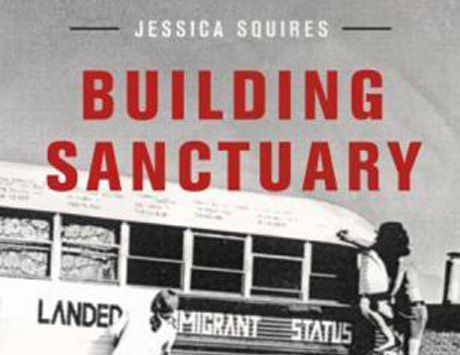Arts
You are here
Review: Building Sanctuary

February 17, 2014
Many Canadians wish to think of their country as a peaceful nation, but that vision is an oversimplification, if not an outright fabrication. Author Jessica Squires writes that if Canada was ever a refuge from militarism, "it was a hard-fought and bitterly defended refuge as well as a contingent and partial one, at best".
Building Sanctuary: the movement to support Vietnam War resisters in Canada 1965-73 is Squires's detailed academic study of the Canadian anti-draft movement and its fight to allow Vietnam War resisters from the United States to legally cross the border into Canada and apply for permanent residence in their new country. Squires relies on interviews with both activists and resisters, as well as newspaper accounts, police records, and government documents (both public and internal), to present a detailed history of the movement.
Squires defines a war resister in this context as "any American immigrant who came to Canada to avoid complicity in, or out of opposition to, their government's actions in Vietnam". Squires favours this broad, inclusive definition, because it takes in draft dodgers as well as deserters, and women who came north in protest of the US’s murderous foreign policy.
As Squires expertly explains, support and acceptance of Vietnam War resisters in Canada was neither automatic nor unproblematic. While Canada encouraged immigration from the US throughout the 1960s, the issue of draft dodgers coming north towards the end of that decade began to complicate things. While the US was still regarded as a source of skilled workers, the Canadian government did not want to be seen as encouraging war resisters.
The first groups to offer assistance to Vietnam War resisters formed in late 1965 and early 1966 in Montreal, Toronto, and Vancouver, publishing pamphlets with information on hostel accommodations, tips on securing cheap housing and finding employment, information on immigration law, and how to apply for landed status in Canada. Many church groups and clergy also played an essential role, even if their church members did not support the cause. (Opponents complained about “unwashed cowards” and “long haired Johnnies with strong communist tendencies.”)
In August 1967, Pierre Trudeau's White Paper on Immigration introduced a new points system for establishing the eligibility of potential immigrants. Applicants were awarded points in a variety of categories, including age, level of education, vocational training, occupational demand, and destination. Even with a system in place that was intended to eliminate bias from the process, there were reports of “conscious and explicit obstruction by immigration officers.” Squires reports that false information was regularly given out at border crossings, airports, consulates, and immigration offices.
In early 1968, proof of military discharge was not required for applicants inside Canada, so deserters would come to Canada as visitors and apply for landed immigrant status once they were inside the country. In July 1968, the Trudeau government secretly ended this practice and allowed immigration officers to use their own “discretion” on whether to consider or disregard military status.
Squires notes that “internal departmental memos indicate that this regulation change was specifically intended to prevent deserters from entering Canada.” In some cases, after refusing entry into Canada, Canadian officials then called US border guards to inform them that a military deserter was on his way back. After this information became public—and the government was flooded with letters and telegrams of complaint (some of which Squires quotes)—the government relented and made the announcement in May 1969 that military status was irrelevant at the border.
Building Sanctuary also reports that most anti-draft groups were under constant surveillance for years by both the RCMP and local police forces, even after the border was opened in 1969. There were numerous raids on resisters and their supporters (searching for drugs was a common excuse). There were widespread assumptions in the movement that the RCMP shared information with the FBI; indeed, it appears that plainclothes FBI agents were allowed to operate on their own in Canada.
Squires also discusses some of the internal debates within the movement at the time, including whether some men were avoiding the draft because of anti-war sentiment or personal reasons, whether it was a better strategy for Americans to remain in the US and work to end the war from there, and to what extent should resisters assimilate into Canadian society. One resister explains: “Emigrating to Canada was considered less heroic than going to jail—better than serving ... but still a cop-out.” However, Joseph Jones, a draft dodger, states: “Anyone who presumed to judge how someone should resist was just plain ignorant.”
The academic writing style of Building Sanctuary lacks the narrative drive of a conventional history, but it's an important work of Canadian political and anti-war history. As the movement to allow Iraq War resisters from the US to remain in Canada begins its second decade, the hard work and successes of a previous generation of activists in shaping Canadian immigration policies can offer inspiration and hope.
Look for upcoming book launches near you
Section:










